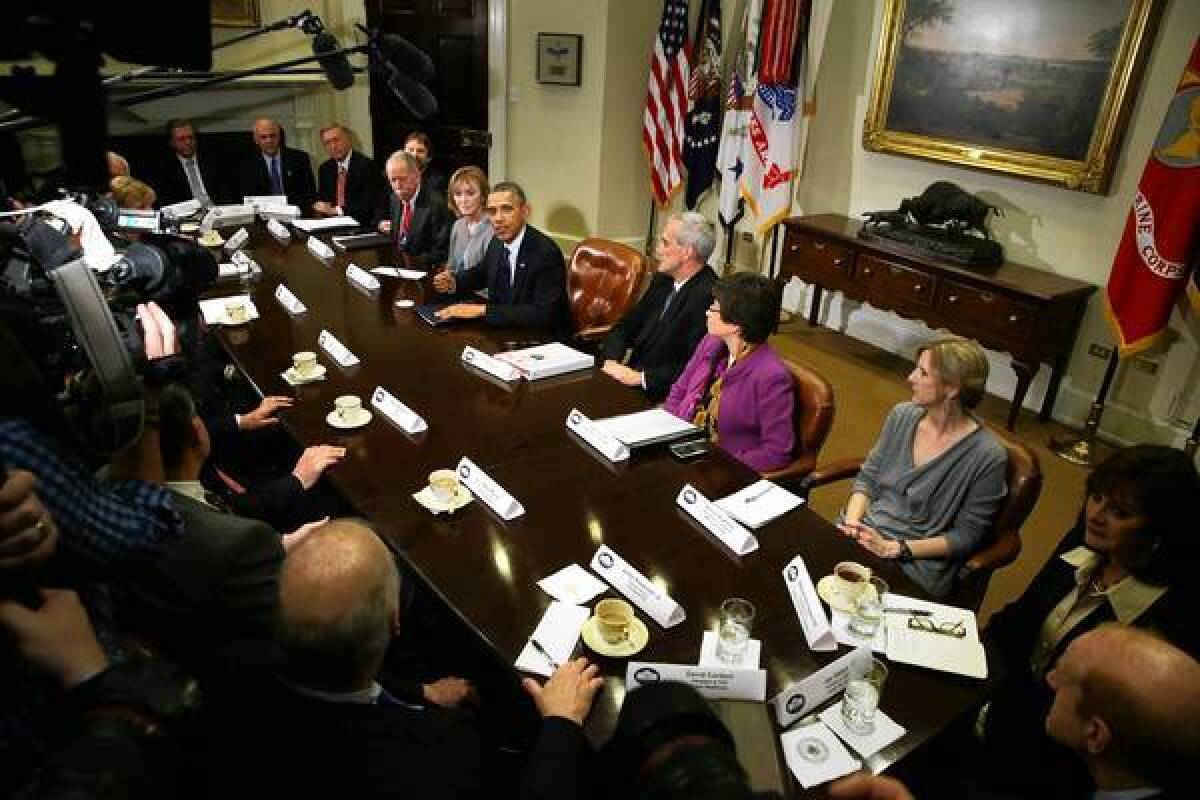White House optimistic Obama will bounce back from healthcare glitches

- Share via
WASHINGTON — He’s vented, attacked, apologized and adjusted. Now, President Obama has one move left in his attempt to salvage the rollout of his healthcare law: hope the website works soon.
The White House, knowing a functional website is needed to calm its panicky allies, has now entered the wait-and-see period of its triage after the turmoil that has followed the Oct. 1 rollout. With the latest fix to the law unveiled, a bruising House vote behind them and experts working feverishly on the broken website, administration officials believe they may have weathered the worst.
Although Obama’s standing in polls and support within his party have dropped sharply, much like the downward trajectory of George W. Bush’s second term, White House officials believe he can still recover.
That optimistic assessment depends almost entirely on the administration’s ability to reboot healthcare.gov, the once-hyped online insurance marketplace now undergoing extensive repair. At stake are the future of the president’s signature domestic achievement, his political standing and reelection prospects for vulnerable Democrats in Congress.
If the administration meets its goal of a mostly glitch-free site by the end of November, the last two months may be remembered as just another near-death experience for a healthcare overhaul that has had many. Even though many insurance executives and congressional Democrats are angry at Obama for his handling of the healthcare law, both groups have strong incentives to help the Affordable Care Act succeed.
But if the White House fails, the recent setbacks could become the beginning of years of trouble for Democrats in office, as well as those seeking to get there, officials concede.
Administration officials privately acknowledge that no argument defending Obamacare will connect with Americans until they begin to see the effects of the law at work. No work-around or temporary fix will reach enough people to build a critical mass of support. The website has to function, admit edgy aides who sometimes spit the word “website” with the contempt familiar to anyone who has ever called a tech help desk.
Obama revealed his own frustrations Thursday, saying at a White House news conference that he has an obligation to show Americans that the law has made health insurance more affordable and accessible — “if we can just get the darn website working and smooth this thing out.”
Officials said Friday they were making progress on the site’s many glitches and bugs. It now takes less than one second, on average, to load a page, down from eight seconds in the weeks after the launch, said Jeffrey Zients, a former top administration official who was brought back to oversee the repairs. The site can “comfortably” handle 20,000 to 25,000 consumers at the same time and more capacity is being added, he said.
Still, problems persist in the system that sends consumer information to insurers, and as experts have ticked off 200 software problems, more continue to pop up. Zients said the officials expect to make the Nov. 30 goal, but added: “Not all consumers going on the website will have a seamless experience.”
While the tech team works, the president must convince his allies as well as his potential adversaries that, as he said Thursday, he’s a clutch player who knows how to recover from a fumble.
That group includes insurance executives who were called to the White House on Friday to discuss Obama’s answer to the millions of policy cancellation notices sent to surprised consumers. After announcing Thursday that he would allow insurers to rescind those cancellations and extend the policies for another year, the president sought to persuade the executives to take him up on the offer.
The group also includes Democrats on Capitol Hill, many of whom have gone from disgruntled to distrustful of the White House. On Friday, 39 House Democrats voted for the GOP alternative to Obama’s extension fix.
That sizable number of largely swing-district lawmakers was only the most visible sign of broader dissatisfaction that makes Obama’s current holding pattern a challenge. Even those who stuck with the White House on Friday’s vote have expressed frustration. In the wake of Obama’s announcement, lawmakers were left to figure out whether their state officials and insurers would go along with the plan. Skepticism was high.
“The message from the White House is, ‘OK, you can be mad, it’s frustrating. But be on the program,’” said one advisor to a House Democrat, who asked for anonymity while characterizing internal discussions. “But what program is that? The program where every five minutes there’s a different plan?”
Polling shows the public has similar doubts. For the first time in his presidency, fewer than half of Americans polled told Gallup that Obama was a “strong and decisive leader,” a 6-percentage-point drop since September. The perception of Obama as “honest and trustworthy” and public confidence in his ability to manage government took a similar tumble.
A continued slide, combined with continued technical glitches, could leave the White House little choice but to make additional changes to the law — mostly likely extending the enrollment period and delaying the penalties for people who don’t carry insurance. Senate Democrats already have urged such a move.
But in the face of ardent Republican opposition to the law — House Speaker John A. Boehner (R-Ohio) on Friday repeated his hope to repeal “this train wreck” — the White House has resisted any fix that puts it at the mercy of House Republicans and pushes votes on the law well into an election year.
“That will always be an option of extreme last resort,” said Drew Altman, president and chief executive of the Kaiser Family Foundation.
The White House has long argued that the popularity of the healthcare law will hinge on the popularity of its benefits — an untested theory until the public can easily access the online marketplaces that showcase most of those benefits. Still, in the pileup of bad news for Obama, there was some reason to hope that the policy now largely locked behind the broken site might have a chance of winning over the public.
Though enrollment numbers in October were dismal, consumer interest was strong. Nationwide, more than 1.1 million people completed applications to get coverage; 106,000 actually selected a plan.
Data from several states operating their own marketplaces suggest demand for health plans may be accelerating.
In California, 35,000 people selected a health plan in October. Nearly the same number signed up in just the first two weeks of November, according to Covered California, the state’s marketplace. Kentucky has seen similar growth: 5,586 people signed up in October, and nearly 4,000 did in the first two weeks of November.
“We are feeling incredibly optimistic,” said Gwenda Bond, a spokeswoman for the state health agency that operates Kentucky’s marketplace, known as kynect.
The White House may have a long wait, Altman noted, before it knows how far that optimism will spread.
“In the long term, ultimately, the website will be working, this issue of cancellations will be in the rear-view mirror and the real question will be whether people who get coverage under the law like it or not,” Altman said. “The real story about whether the law works or not will unfold next year and the year after that.”
kathleen.hennessey@latimes.com
Times staff writer Noam N. Levey contributed to this report.
een.hennessey@latimes.com”>kathleen.hennessey@latimes.com
Times staff writer Noam N. Levey contributed to this report.
More to Read
Sign up for Essential California
The most important California stories and recommendations in your inbox every morning.
You may occasionally receive promotional content from the Los Angeles Times.












